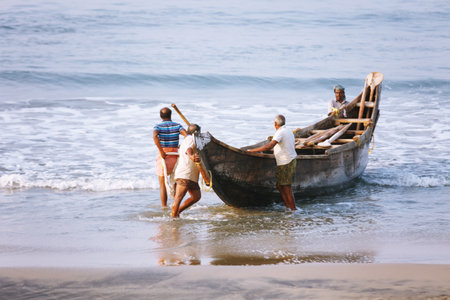Overview of Fishing Licences in India
Fishing is an age-old tradition in India, deeply interwoven with the country’s diverse cultural and ecological landscapes. Whether you are angling for Mahseer in Uttarakhand’s rapid rivers, casting nets in the Kerala backwaters, or exploring the coastal waters of Goa, each region presents its own unique environment—and its own set of legal requirements for fishing. The Indian government has established a structured system of fishing licences to regulate these activities, not only to conserve aquatic resources but also to ensure sustainable livelihoods for local communities.
The fishing licence system in India is not uniform across all states; rather, it reflects the country’s remarkable regional diversity. Different state governments manage their own fisheries departments and have developed varied licensing procedures, taking into account local fish species, environmental concerns, and community practices. For instance, Himachal Pradesh and Jammu & Kashmir have strict rules for trout fishing in mountain streams, while states like West Bengal and Assam regulate riverine and floodplain fisheries with distinct policies. In southern states such as Tamil Nadu and Karnataka, inland and marine fishing licences operate under separate guidelines. This diversity means that both Indian citizens and foreign nationals must pay careful attention to local regulations before planning any fishing trip in the country.
2. Types of Fishing Licences Available
In India, fishing licences are mandatory for anyone who wishes to engage in fishing activities, whether for leisure or business. These licences ensure that fishing is conducted in a regulated and sustainable manner, protecting aquatic ecosystems and supporting local livelihoods. Both Indian citizens and foreign nationals must obtain the appropriate licence before casting a line in Indian waters. Below is an explanation of the main categories of fishing licences available across the country:
Recreational Fishing Licence
This type of licence is designed for individuals who fish as a hobby or for personal consumption, rather than for profit. It usually covers angling in rivers, lakes, reservoirs, and certain designated tourist spots. The terms and conditions may vary depending on the state or specific water body. For foreign tourists, special short-term recreational licences are often issued to facilitate sport fishing experiences during their visit.
Commercial Fishing Licence
Commercial fishing licences are required for those engaged in fishing as a livelihood or business activity. This includes large-scale operations using boats, nets, and other commercial equipment. The regulations under this category are more stringent, with quotas, gear restrictions, and reporting requirements to prevent overfishing and ensure resource sustainability.
State-Specific Permits
India’s federal structure means that each state has its own set of rules and permits regarding fishing activities. States like Kerala, Goa, Himachal Pradesh, Assam, and Uttarakhand issue their own fishing permits tailored to local conditions and species conservation efforts. Foreign nationals must often apply directly through state fisheries departments or authorised tour operators for these permits.
Overview Table: Common Fishing Licence Categories in India
| Licence Type | Who Can Apply | Main Purpose | Validity Period | Issuing Authority |
|---|---|---|---|---|
| Recreational/Sport Fishing Licence | Indian citizens & Foreigners | Hobby/Leisure/Personal Use | 1 day – 1 year (varies) | State Fisheries Dept./Tourism Boards |
| Commercial Fishing Licence | Registered Indian businesses & Individuals (Foreigners via JV/permits) | Business/Livelihood/Export | Annually renewable | Central/State Fisheries Dept. |
| State-Specific Permit | Mainly Tourists & Local Anglers | Fishing in specific water bodies/Protected areas | Day/week/month (varies) | Respective State Authorities |
Cultural Note:
The process and terminology related to fishing licences can differ widely between North Indian hill states (like Himachal Pradesh), coastal regions (such as Kerala and Goa), and inland riverine zones (like Assam). For instance, terms like “angling permit” or “mahseer licence” might be used locally. Foreign nationals are advised to check the latest guidelines from the state where they intend to fish to ensure compliance with all legal requirements.

3. Application Procedures for Foreign Nationals
Applying for a fishing licence in India as a foreign national is a straightforward process if you follow the recommended steps and prepare your documents in advance. The Indian government, along with several state fisheries departments, has streamlined the process through online portals and dedicated application centres to ensure a hassle-free experience for visitors.
Step-by-Step Guide to Applying for a Fishing Licence
Step 1: Choose Your Fishing Destination
First, decide whether you intend to fish in national parks, rivers, lakes, or coastal areas. Each region may have its own authority issuing licences, so check with the respective State Fisheries Department or local tourism office for region-specific rules.
Step 2: Prepare Required Documentation
- Valid passport with visa details
- Recent passport-size photographs
- Proof of address in India (hotel booking, rental agreement, or host’s letter)
- A completed application form (available online or at regional offices)
Step 3: Register Online or Visit an Application Centre
Many Indian states now offer online portals such as the National Fisheries Development Board website or state-specific platforms (e.g., Uttarakhand Tourism, Karnataka Fisheries). If online application is unavailable for your chosen area, visit the nearest District Fisheries Office or Tourist Facilitation Centre.
Step 4: Submit Application and Pay Fees
Upload scanned copies of your documents on the portal or submit them in person. Pay the prescribed fee using accepted payment methods—Indian Rupees via credit/debit card or bank transfer are preferred. Keep your payment receipt safely as proof.
Step 5: Collect Your Licence and Read Regulations
Once your application is processed—usually within a few working days—you will receive either an e-licence via email or a physical copy from the issuing office. Carefully read all terms and conditions attached to your licence, including allowed fishing zones, timings, and permissible equipment.
Tips for Hassle-Free Application
- Apply well in advance during peak seasons to avoid delays.
- If you need help navigating local systems, seek assistance from your hotel concierge or recognised travel agents.
- Carry both digital and hard copies of your licence while fishing to avoid any inconvenience during on-the-spot checks by authorities.
This systematic approach ensures that foreign anglers can enjoy India’s diverse fishing destinations without legal complications, making their angling adventure memorable and compliant with local laws.
4. Special Provisions and Restrictions for Foreigners
Foreign nationals planning to indulge in angling adventures across India must comply with a set of additional rules and restrictions designed to protect the country’s aquatic biodiversity. Besides obtaining the standard fishing licence, foreigners are required to adhere to specific provisions that differ from those applicable to local anglers. These special measures ensure responsible tourism and conservation of sensitive ecosystems.
Protected Zones and Restricted Access
India boasts several protected areas, including national parks, wildlife sanctuaries, and community reserves, where fishing activities are either strictly regulated or completely prohibited. Some renowned rivers like the Ganges and Brahmaputra also have sections designated as “No Fishing Zones” due to ecological sensitivity or religious significance. Foreigners must check with the respective state fisheries department or local authorities regarding access permissions before planning any trip.
Special Fees for Foreign Nationals
Unlike Indian citizens, foreign anglers are often subject to higher licence fees and additional charges depending on the state and the nature of water bodies. The table below offers a general overview of the fee structure:
| State/Region | Fee Type | Indian Citizens | Foreign Nationals |
|---|---|---|---|
| Himachal Pradesh | Daily Licence | INR 100 | INR 500 |
| Karnataka (Cauvery) | Weekly Permit | INR 1,000 | INR 5,000 |
| Sikkim | Seasonal Pass | INR 2,000 | INR 10,000 |
*Fees are indicative and subject to change; always confirm with official sources.
Bag Limits & Gear Restrictions
The number and size of fish that can be caught per day (bag limits) are strictly enforced for foreign anglers. Additionally, certain types of gear such as nets, traps, or multi-hook systems may be prohibited in sensitive areas. Only rod-and-line fishing is generally allowed for tourists in most states. It is vital to read through the specific guidelines mentioned on the licence document or consult local guides for compliance.
Summary of Key Limitations for Foreign Anglers
- No fishing in designated protected zones without explicit permission.
- Higher licence fees compared to residents.
- Certain species (e.g., Mahseer) may have catch-and-release mandates.
- Lodging details may be required as part of permit application.
Cultural Sensitivity & Responsible Practices
Foreign anglers are expected to respect local customs and traditions, especially near holy rivers or during regional festivals when fishing might be temporarily banned. Adhering to all regulations not only ensures a hassle-free experience but also contributes positively to India’s efforts in sustainable fisheries management.
5. Popular Fishing Destinations and Local Practices
Highlighting Indias Renowned Angling Locations
India is a paradise for anglers, offering a diverse range of fishing destinations that attract both locals and international enthusiasts. Among the most celebrated spots are the Ramganga River in Uttarakhand, famed for its mighty Mahseer; the Cauvery River in Karnataka, known as the home of the legendary hump-backed Mahseer; and the pristine streams of Himachal Pradesh and Arunachal Pradesh, which host species like trout and snow trout. In addition, Kerala’s backwaters and the Ganges delta in West Bengal provide unique opportunities for estuarine and saltwater fishing experiences.
Best Seasons for Angling Adventures
The optimal time for fishing in India varies by region and target species. Generally, the post-monsoon period from October to March is considered ideal across northern rivers, as water levels stabilize and fish activity increases. In southern regions like Karnataka and Kerala, November to February offers pleasant weather and abundant catches. However, it is essential to check local regulations since certain species have closed seasons for spawning, particularly Mahseer from June to August.
Understanding Local Etiquette and Customs
Respecting Indian angling traditions enhances your fishing experience. Always seek permission or secure proper licences before fishing, especially in community-managed waters or private stretches. It is customary to greet local anglers with a polite “Namaste” and engage in friendly conversation about techniques or recent catches. Many Indian fishermen practice catch-and-release, especially for threatened species like Mahseer—adopting this custom is greatly appreciated. Additionally, avoid littering; carry back all refuse to maintain the natural beauty of these destinations.
Cultural Insights for Foreign Nationals
When interacting with local guides or tribal communities who manage fishing spots, showing humility and willingness to learn their methods—be it fly fishing, spinning, or traditional bamboo rod angling—is highly valued. Offering thanks with an “Dhanyavaad” (thank you) goes a long way. Remember that some religious sites near rivers may require modest attire and respectful conduct; always observe posted signs and local advice.
Ensuring a Respectful and Enjoyable Experience
To make your Indian fishing adventure memorable, blend patience with curiosity. Learn about regional fish species, support sustainable tourism by hiring certified guides, and participate in conservation initiatives if possible. By embracing local practices and customs, foreign nationals not only comply with Indian regulations but also foster goodwill with host communities—making every cast a cultural exchange as well as an angling pursuit.
6. Compliance, Penalties, and Conservation Norms
Fishing in India is not just about enjoying the country’s rich aquatic resources; it comes with a responsibility to respect local laws and community practices. Adhering to Indian fisheries regulations is crucial for all anglers, especially foreign nationals, as these rules are designed to maintain ecological balance and sustain fish populations for future generations.
The Importance of Compliance
India’s diverse river systems and water bodies support numerous livelihoods and cultural traditions. As such, strict adherence to licensing conditions—such as permitted fishing zones, seasons, gear restrictions, and catch limits—is essential. Following these norms helps prevent overfishing and protects endangered species like Mahseer and Hilsa.
Legal Consequences of Violations
Violating fishing regulations can lead to serious legal consequences. Foreign nationals found fishing without a valid licence or breaching specific provisions may face fines, confiscation of equipment, or even deportation in severe cases. Local authorities regularly conduct checks, and ignorance of the law is not accepted as an excuse. It is always advisable to keep your documentation handy and seek clarification from local fisheries departments if you are unsure about any rule.
Community-Based Conservation Efforts
Many Indian communities have established their own conservation initiatives, such as community-managed fish sanctuaries and seasonal bans during spawning periods. Participating respectfully in these efforts not only ensures compliance but also builds goodwill among locals. These measures have proven effective in reviving fish stocks and supporting sustainable tourism.
In summary, respecting India’s fisheries rules is both a legal obligation and a contribution to preserving its natural heritage. By complying with regulations and participating in local conservation efforts, foreign anglers help ensure that India remains a top destination for fishing enthusiasts worldwide.


